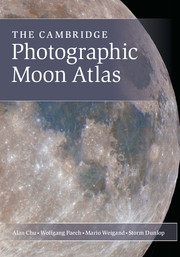Book contents
- Frontmatter
- Preface
- Advice on using this book
- Contents
- The Moon – an introduction
- Atlas of lunar formations
- 1 Mare Smythii
- 2a Mare Crisium
- 2b Mare Crisium
- 3 Cleomedes
- 4 Endymion
- 5 Atlas/Hercules
- 6 Montes Taurus
- 7 Palus Somni
- 8a Mare Fecunditatis
- 8b Mare Fecunditatis
- 9 Langrenus/Petavius
- 10 Mare Australe
- 11 Vlacq
- 12 Vallis Rheita
- 13a Mare Nectaris
- 13b Mare Nectaris
- 14 Rupes Altai
- 15 Abulfeda
- 16 Theophilus
- 17 Sinus Asperitatis
- 18 Statio Tranquillitatis
- 19a Mare Tranquillitatis
- 19b Mare Tranquillitatis
- 20a Mare Serenitatis
- 20b Mare Serenitatis
- 21 Posidonius
- 22 Lacus Mortis
- 23 Aristoteles/Eudoxus
- 24 Montes Caucasus
- 25 Autolycus/Aristillus
- 26 Cassini
- 27 Montes Alpes
- 28 Plato
- 29 Montes Teneriffe
- 30 Archimedes
- 31a Montes Apenninus
- 31b Montes Apenninus
- 32 Mare Vaporum
- 33 Rima Ariadaeus
- 34 Rima Hyginus
- 35 Sinus Medii
- 36 Hipparchus
- 37a Ptolemaeus
- 37b Ptolemaeus
- 38 Rupes Recta
- 39 Regiomontanus
- 40 Maurolycus
- 41 South Pole
- 42 Clavius
- 43 Tycho
- 44 Schiller
- 45 Palus Epidemiarum
- 46 Pitatus
- 47 Mare Nubium
- 48 Fra Mauro
- 49 Mare Cognitum
- 50 Mare Insularum
- 51a Copernicus
- 51b Copernicus
- 52 Eratosthenes
- 53a Mare Imbrium
- 53b Mare Imbrium
- 54 Sinus Iridum
- 55 Gruithuisen
- 56 Mare Frigoris
- 57 North Pole
- 58 Aristarchus
- 59 Kepler
- 60 Seleucus
- 61 Reiner
- 62 Letronne/Hansteen
- 63 Gassendi
- 64 Mare Humorum
- 65 Schickard
- 66 Sirsalis
- 67 Grimaldi
- 68 Mare Orientale
- 69 Lunar Farside
- Glossary
- Index of lunar features
- Image credits
- Further reading and references
44 - Schiller
Published online by Cambridge University Press: 05 October 2012
- Frontmatter
- Preface
- Advice on using this book
- Contents
- The Moon – an introduction
- Atlas of lunar formations
- 1 Mare Smythii
- 2a Mare Crisium
- 2b Mare Crisium
- 3 Cleomedes
- 4 Endymion
- 5 Atlas/Hercules
- 6 Montes Taurus
- 7 Palus Somni
- 8a Mare Fecunditatis
- 8b Mare Fecunditatis
- 9 Langrenus/Petavius
- 10 Mare Australe
- 11 Vlacq
- 12 Vallis Rheita
- 13a Mare Nectaris
- 13b Mare Nectaris
- 14 Rupes Altai
- 15 Abulfeda
- 16 Theophilus
- 17 Sinus Asperitatis
- 18 Statio Tranquillitatis
- 19a Mare Tranquillitatis
- 19b Mare Tranquillitatis
- 20a Mare Serenitatis
- 20b Mare Serenitatis
- 21 Posidonius
- 22 Lacus Mortis
- 23 Aristoteles/Eudoxus
- 24 Montes Caucasus
- 25 Autolycus/Aristillus
- 26 Cassini
- 27 Montes Alpes
- 28 Plato
- 29 Montes Teneriffe
- 30 Archimedes
- 31a Montes Apenninus
- 31b Montes Apenninus
- 32 Mare Vaporum
- 33 Rima Ariadaeus
- 34 Rima Hyginus
- 35 Sinus Medii
- 36 Hipparchus
- 37a Ptolemaeus
- 37b Ptolemaeus
- 38 Rupes Recta
- 39 Regiomontanus
- 40 Maurolycus
- 41 South Pole
- 42 Clavius
- 43 Tycho
- 44 Schiller
- 45 Palus Epidemiarum
- 46 Pitatus
- 47 Mare Nubium
- 48 Fra Mauro
- 49 Mare Cognitum
- 50 Mare Insularum
- 51a Copernicus
- 51b Copernicus
- 52 Eratosthenes
- 53a Mare Imbrium
- 53b Mare Imbrium
- 54 Sinus Iridum
- 55 Gruithuisen
- 56 Mare Frigoris
- 57 North Pole
- 58 Aristarchus
- 59 Kepler
- 60 Seleucus
- 61 Reiner
- 62 Letronne/Hansteen
- 63 Gassendi
- 64 Mare Humorum
- 65 Schickard
- 66 Sirsalis
- 67 Grimaldi
- 68 Mare Orientale
- 69 Lunar Farside
- Glossary
- Index of lunar features
- Image credits
- Further reading and references
Summary
Schiller 51.9°S, 39.0°W
Schiller is one of the few truly elliptical craters, having measurements of 70 × 180 km. The southern portion of the crater's floor is smooth and level, the northern portion is rough and furrowed and has two mountain peaks. Schiller probably once consisted of two or more overlapping craters. NASA experiments in the 1960s have shown that such a structure may result from a further impact that occurs at a very low angle (of just a few degrees), and may perfectly well lead to a form of crater like Schiller.
Schiller-Zucchius Basin
The region between the craters Schiller and Zucchius is a multiring basin with two, or possibly three, concentric rings of mountain chains (basin ramparts). The inner ring, about 200 km in diameter, cuts the crater Segner, and the second ring, about 330 km in diameter, cuts across the crater Zucchius. Like many other basins, the Schiller-Zucchius Basin also shows a gravity anomaly (a mascon).
Bailly 66.5°S, 69.1°W
Bailly is the largest crater that may be observed on the nearside of the Moon (and is described on older Moon maps as a walled plain). Nevertheless, because of its extreme position on the limb it is not very conspicuous, and because of the curvature of perspective at the limb is distorted into an extremely elliptical shape. Bailly has a diameter of nearly 300 km, and as such is classified as a medium-size impact basin.
- Type
- Chapter
- Information
- The Cambridge Photographic Moon Atlas , pp. 134 - 135Publisher: Cambridge University PressPrint publication year: 2012



